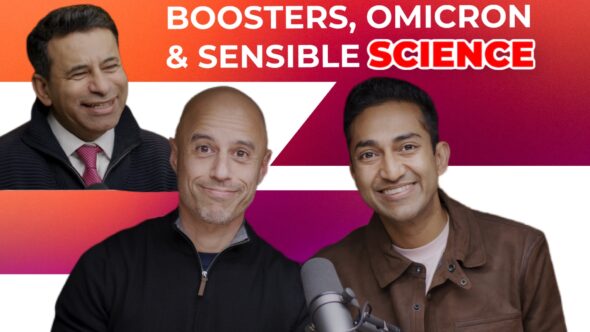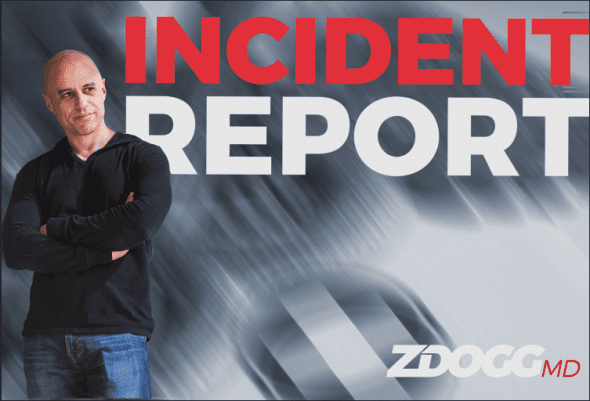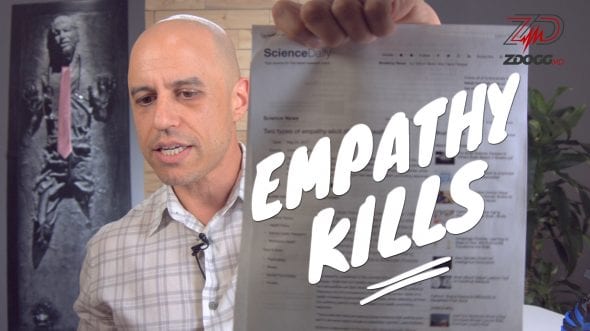COVID-19 doesn’t spread like flu; it “clusters.” It turns out this may matter. A lot.
The Atlantic article I referenced.
Transcript Below
Welcome to The ZDoggMD show. We’re live it’s October 1st, the first day of fall, about 4:20 p.m. Pacific time. California’s on fire. What else is new? 2020 is on fire. That’s been going on for months.
So I wanted to talk today though, and there won’t be bad language or anything like that, like in my last live broadcast. So this is really about sharing this, because there’s a new piece out in the Atlantic, which has been plus or minus for science. Occasionally, they hit it right, and I think this piece was really intriguing, and it’s about a metric for understanding COVID that we haven’t been talking about enough publicly, and that is something called dispersion or kappa, something like that. None of that really matters.
Here’s what you need to know. The article was super long, I’ve link to it in the description. It can be summarized thusly. Influenza, flu spreads in a pretty different way than COVID, and it really occurs like this. In flu, each person who is infected can be roughly equivalently infectious as the next person. So in other words, it’s kind of a linear infectivity. If you’re infected, you’re likely to infect other people and those other people are likely to infect other people in a similar way, and it’s not perfect, there’s outliers, and it’s more complex than that, but that’s how you think about influenza, and that’s how so we have been treating COVID.
In other words, every case, every single case is considered a massive threat for infection. What’s going on with COVID is something different, because instead of like the reproductive number, in other words, how many other people a single person on average can infect. What this article was talking about is something called the dispersion number. So in other words, how uneven is that infectivity? How clustered is it? And a disease that is considered over dispersed like COVID, like SARS the original, like MERS, Middle Eastern the syndrome thing, they behave very similar, they cluster.
So there are these individuals super spreaders that a single individual like in South Korea in a mega church can be responsible for 5,000 infections in a super spreading event, and those events can be understood and potentially prevented in a targeted way that then saves us the heartache and the ordeal of what we’ve done and said in the United States, where we treat everything with a hammer and think everything’s a nail.
So the way that COVID kind of has been unfolding is you have these individuals through unknown reasons, something like 10 to 20% of infected cases cause 80 to 90% of the disease spread in some series that are cited in this article. Now, that’s something that is called a Pareto curve, to get technical. Basically it means, basically what we experience in life, in customer service, 5% of the customers cause 90% of the chaos and unhappiness for retail workers. 20% of the patients with chronic severe disease cost 80% of the healthcare dollars, or 5% of patients cost 50% of healthcare dollars. This is a known sort of phenomenon in nature, and in COVID it becomes very important, because when you start to look at the differences between countries, what you start to realize is whereas flu spreads in what they call a deterministic way, in other words, you get some infections then infect other people, they infect other people in a relatively predictable way, where if you know what the inputs are, these guys are infected, you can pretty reasonably predict what’s gonna happen with the infection.
COVID, because of this over dispersion and clustering, where only certain individuals really spread it, others may only spread it to one other person, which means the rate of growth is not gonna be increasing, or they don’t spread it at all. They can still get sick, but they don’t spread it all. And there’s this asymptomatic component where you don’t have symptoms, right? Well, with COVID, there’s something called stochastic effect. Stochastic is a fancy word that epidemiologists and math people, and statisticians like to throw around, it basically means random.
So it means that if you know the inputs, in other words, these guys are infected, you actually can’t really predict what’s gonna happen down the line cause you don’t really know who the super spreaders are, where they are, and in what situations they’re placed, because all of those things will change the outcome.
Now, why is this so important? It’s really important for the following reasons. The first is, look at, let’s say Sweden and Japan, and let’s compare them to say, the rest of the world or the US. What happened in Sweden. Sweden is kind of held up as this model of either you love them or you hate them. You think they did great or you think they killed a bunch of people. Early on, bunch of deaths, more than their neighbors, largely in the nursing home population, which they failed to protect. They never did massive shutdowns, but they did a few things that were very… It turns out in retrospect, were extremely targeted to an over dispersed disease spread model of super spreaders. What do I mean by that?
It means, in order to have a super spreading event, you need the following things, and you don’t need all of them, but you need enough of them. You need a super spreader. So you need an individual who’s infected, who’s likely asymptomatic, doesn’t know they’re infected. Is one of these people that just happens to aerosolize virus, maybe they have a higher viral load in their nasopharynx, maybe they tend to cough more, who knows what it is? We don’t know yet, right? And it doesn’t really matter yet, although knowing that would help us identify these people earlier. So you need that person.
Then you need an environment where people are in a poorly ventilated, indoor space, with a large crowd so that you can get enough seeding of people that if you infect them, there’s enough people there that one of those guys is likely themselves to be a super spreader, which means you create a chain of super spreading events by generating more. It’s kind of like, you know, there’s only one superhero per 10,000 people or whatever that’s magical. Well, if that superhero could infect enough people, the lucky one will then infect more people and you get this chain of transmission. That was the dumbest analogy I’ve ever made. I love it though.
So what happened in Sweden is they said, okay, what’s the other things that affect super spreading? So crowded location, poor ventilation, super spreader, prolonged contact. So you need to be in that space where the virus is circulating from the super spreader, again, with the poor ventilation. And it helps if there’s an event like singing, chanting, loud talking that allows even more amplification of the super spreader. Well, what are those kinds of places? Large gatherings, like big concerts, events like that, big churches, big churches with poor ventilation, restaurants and bars, weddings, funerals, et cetera, et cetera, et cetera.
So what did Sweden do? They said, no, don’t shut down society, the government’s gonna do the following. We’re gonna ban gatherings of more than 50 people, which by the way, was pretty aggressive even at the time, and they persisted with that. The rest of Europe actually started to open up to those things, not Sweden. They said, no, no, no, that’s one thing we’re keeping wraps on.
The second thing they did is they said, well, okay, you guys should physically distance. The government’s just telling you do your best to avoid, you know, big crowds, but you don’t need to wear masks necessarily. And here’s another thing. Who are more likely to be super spreaders? Young children under 16 or 16 and older? Well, it turns out there’s a fair bit of feeling and evidence that young children aren’t really these super spreaders. Doesn’t mean they can’t get it, doesn’t mean they can’t spread it with a few people, but they’re less likely to be super spreaders.
So what did Sweden do? They kept their elementary and lower schools open, and the higher schools, high schools and universities went to online. Hmm. What else is unique about Sweden? Their households, 50% of them are single individuals. They don’t have the multi generational households in the large household numbers indoors, poorly ventilated space that the rest of Europe and even America tends to have.
Well, so what ended up happening? Their elders got sick very early and they had a lot of cases and deaths early on, their healthcare system got busy, never overwhelmed, got busy, because they didn’t think that nursing homes are enclosed spaces with very vulnerable people, and it just takes one super spreader visitor to kill a lot of people. And as that died off, they have not seen a large resurgence in deaths or cases, whereas the rest of Europe is seeing that. So that’s a big signal, right? That okay, this super spreader thing is important.
What did the Koreans do? They took a different approach, because they said, okay, same things are true. We’re already the victim of these big, super spreading events. One woman in a mega church, 5,000 cases. They took the approach that in super spreader events, contact tracing, you can do it two ways. You can say, okay, somebody is a case, they’re infected. Hmm, let’s test them and then… Well, of course we tested them then we know they are case. Let’s test everyone they’ve been in contact with since they got infected to make sure we can identify all the people they’ve transmitted the disease to and block the transmission chain. So that’s forward contact tracing. Okay.
Well, that’s great if it were a normally dispersed disease, not an over dispersed disease that occurs in clusters, because what happens if you’re contact tracing a single case? How likely is that case to infect other people? Well, if 10 or 20% of people are causing 80 or 90% of the cases, you’d have to be pretty lucky to find that 10 or 20% in the case that you have. So forward tracing is gonna have some utility, but not a lot, not as much as backward tracing. Backward tracing was used by the Koreans. They said, okay, we have some cases here. Let’s go back in time. Where has this person been before they got infected? What venues? What enclosed spaces with crowds and poor ventilation where they would be exposed for a long time to a super spreader might be?
And they would go backwards and they would find out, okay, so who were in those venues and test those people. And then they would find a ton of cases, because that’s where the super spreading event occurred. And that backward tracing could then allow you to test a ton of people and stop the further chain of super spreader events. So the South Koreans managed to do that.
The Japanese did something very similar. They have an elderly population, very dense, lot of crowds, they didn’t shut everything down, they didn’t have a lot of testing. They did aggressive backwards contact tracing and encouraged businesses that were high risk, like bars and restaurants, things like that to do the right thing. Well, they have a relatively good outcome so far, knock on wood.
Now, this is the piece of this that becomes really important. So when I said stochastic, in other words, you don’t really know what’s gonna happen based on the inputs, because there’s a random component and who’s the super spreader and where are they, and how unlucky are you? Why is it that similar environments had very different outcomes? Look at Italy. The Lombardy region had like the majority of the cases in the deaths compared to say, Rome or somewhere like that. These are similar, let’s say you’re comparing apples to apples, which they did in the article. Same thing in Korea, two different cities, similar demographics, similar density, totally different outcomes, why?
Blind luck. When the disease is clustered, if you end up with just a few more clusters in one location due to bad luck and more super spreaders, the thing grows exponentially in that location, but then in other locations, you hardly get anything. Think of New York. How many people came in and that were positive? How many super spreader events did you have early on before you knew what was going on? Asymptomatic spread, boom, it explodes. Then they quickly wrap their head around what’s happening, there’s probably some preexisting immunity, maybe masks helped in crowded environments, they start to make interventions, but really you’re contact tracing and being very aggressive at that point.
Now we have hardly anything in New York, knock on wood. So that’s another explanation for these variances in localities that we’re seeing. Now, let’s extrapolate this to one more level. In the US, sorry in Sweden, they did these very targeted things. And for the most part, and this is still, there’s a little push and pull here. They’re doing okay. In the US what did we do? Well, kind of didn’t really quite understand the clustering thing that well. Treated it as a linear sort of disease. Shut down every single thing, shut down the young kids in school, but kept the universities open. So we did the opposite, and we closed up everything then we open up the bars again, and, you know, initially, and then you see a surge. Why? Because bars are crowded, loud talking, poorly ventilated.
What did Japan do? They also focused on ventilation. We didn’t do any of that. We’re still talking about, you know, surfaces. I was still talking about surfaces in the early days. We’re talking about, you know, wiping down your packages and all that crap, telling people, stay in their homes, stay home, shelter in place. Multi generational, poor families, living in place, get exposed at their essential job to a super spreader, come home, infect their whole family. More diabetes, more hypertension, more heart disease, more obesity in those populations due to social determinants of health and they die, more than your rich affluent suburbanite, who have plenty of spaces, a low household number size, doesn’t need to go into these crowded environments to survive.
We did everything backwards, right? And as more information comes out, as we start to understand the nuance of this, it’s multifactorial, there’s a lot of stuff going on. We can learn from every single idea, every theory, we can debate it. And maybe this is wrong, maybe this super spreader model and dispersion issue is less important than we think, but I suspect that it is an important component, along with other ideas of innate immunity preexisting in the community to previous coronaviruses, age and demographic risk being important. So young people getting less sick mean countries that are younger have less deaths. I mean, this is clear in Africa, India, places like that. There’s a really interesting study in India that came out that I’ll talk about soon. So that’s more or less what I wanted to put on your radar. I’ve link to the article, so it means maybe we need to be targeted.
One thing I hate and I’ve said this from the beginning, mask mandates outside, why? If you’re not in a big crowd outside and you can physically distance, and even if you can’t, there’s infinite ventilation outside, the chances of a super spreader event or something like that are so small, but the chances of really pissing people off and having them not wanna do this are high. Sweden, by the way, never had a mask mandate, but their people basically said if the government said to do it, we do it. The government said, we’re not gonna spend our credibility doing something that we don’t think is necessary right now, given the dynamics in our community. That doesn’t mean it won’t work here. And, you know, in supermarkets, crowded places, places with poor ventilation, a mask can help you. And Monica Gandhi has been on my show talking about that.
All right, so this is what I want you guys to do. Comment. I’ll get a guest on the show to talk about this in more detail. Share this video. Do me a favor. If you like the kind of things we do and you wanna go deeper, and you wanna talk about it more, and you wanna support content that is nuanced and less clickbaity than the mainstream media, join our supporter tribe on Facebook, it’s 4.99 a month. We have these conversations live with all the F bombs and we go deep and it’s two way. You can do it on YouTube as well, and usually get supportive content after the fact that we stream out to YouTube until YouTube gets their act together and lets us live stream, or you can support us on PayPal with a onetime donation that keeps us independent of BS sponsors that would tell us what to say and what we can’t say. And we don’t have to play the social media games. So I love you guys. Keep thinking, keep rational thought going, keep discussion, keep loving each other, that’s probably important. And we out. Peace.
Related Videos
Category
- The ZDoggMD Show (799)
- Featured Videos (188)
- Doc Vader (142)
- Against Medical Advice (128)
- Medical Humor (95)
- Public Service Announcements (87)
- Music Parodies (74)
- Nurses (59)
- Meditation (38)
- ZVlogg (36)
- The VPZD Show (31)
- ZTalks (28)
- ZBlogg (24)






